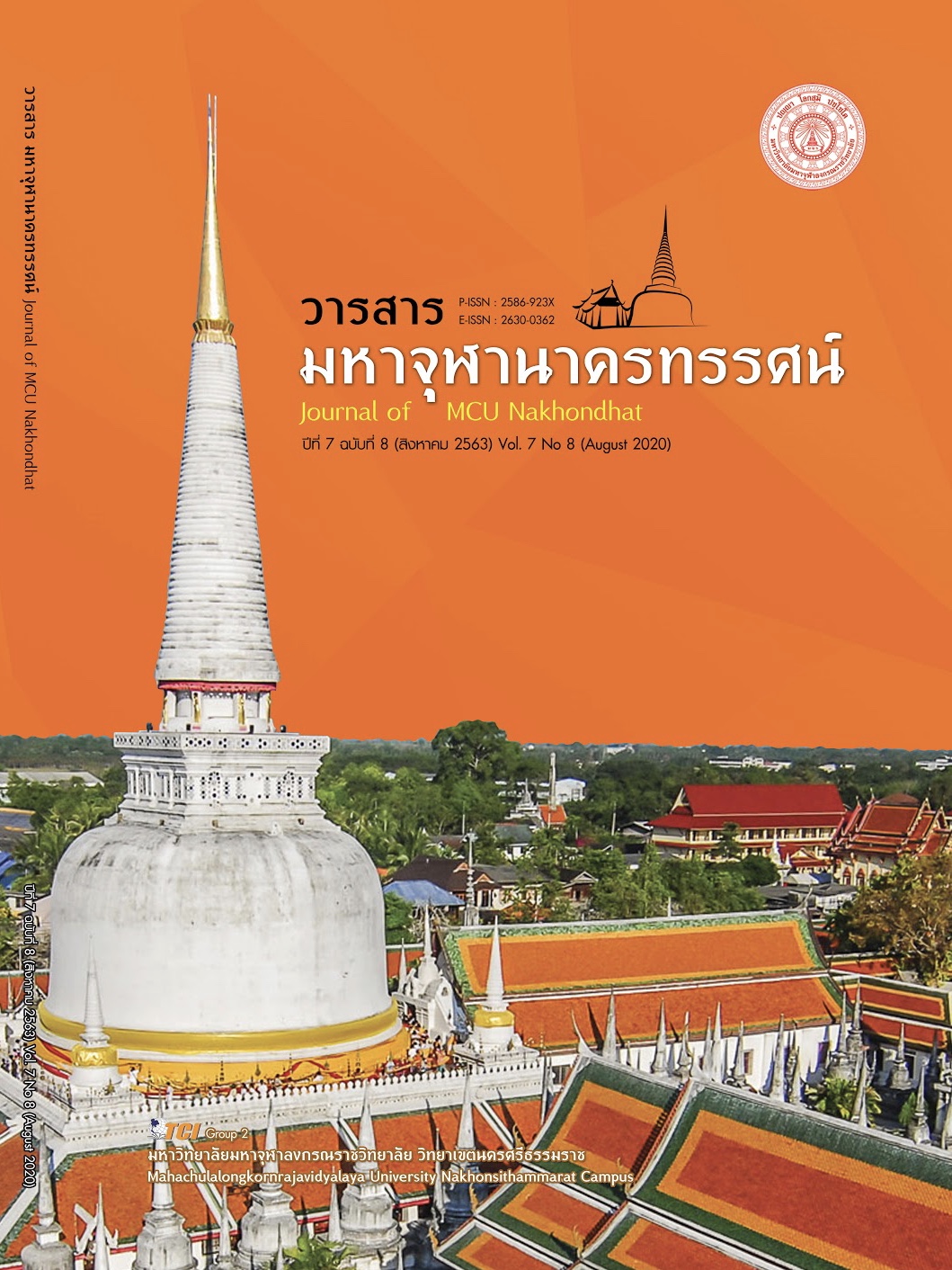AN ANALYTICAL STUDY OF SIGNS APPEARED IN BUNSAT MONTHAN TRADITION OF NAKHON SI THAMMARAT
Main Article Content
Abstract
This research is aimed at To study the history and values of Bunsat Monthan Tradition, Nakhon Si Thammarat Province In order to study the signs in the Bunsat Monthan tradition in Nakhon Si Thammarat and to study the meaning of the sign in the Bunsarunthanon, Mueang Nakhon Si Thammarat tradition. This research is primarily documentary research.By synthesizing, analyzing and presenting the descriptive research results. The research found that; 1) Boon Sarnthan Tenth tradition originated from the way of life in agriculture, respect for spirits, the influence of Brahminism, Buddhism and the seasons related to monks. With the aim of making merit to devote to imp According to the belief that the day of the waning of the tenth lunar month, the gods will release the jinn to visit and request merit from their children. At the end of the 15th lunar month, Jinn will return to Hell. During that time, the children will receive Making merit, raising monks, imposing, contemplating, and praying for merit – making traditions. 2) Bunsat Monthan tradition has a ritual with the sign of the day. The sign of the food that is used to contain food, vegetables, fruits, daily necessities, and ritual snacks.The sign of the candy used in Bunsatthanon Ten, hidden by beliefs, inscriptions and morals, the signs of Jinn with hunger and hunger. The sign of the jinn and the ritual to spread the merit to imp, which does not have relatives and relatives, do not make merit. And the sign of the Requiem to dedicate merit and send back to hell. 3) Bunsat Monthan tradition has signified the meaning related to the way of life, beliefs, religion, history, economy, society and politics. Date and time associated with the first product Worship of the day Making merit for the impetus and the rainy season.Accepting for packing agricultural products, food, sweets and essential supplies is offered to the monks to dedicate merit to jinn.Sweets are mediators between descendants and ancestors and bring meaning to life after death. Pret is a repetitive production of beliefs, ghosts in creating rules and organizing society.The impulse and contemplation is a merit.Divide food and socialization and the reverence of ancestors is grateful and teaches children to be good people.
Article Details
References
ประทุม ชุ่มเพ็งพันธุ์. (2548). ศิลปวัฒนธรรมภาคใต้. กรุงเทพมหานคร: สุวีริยาสาส์น.
พรศักดิ์ พรหมแก้ว. (2544). ความเชื่อและพิธีกรรมเกี่ยวการนับถือผีกับบทบาททางสังคมของชาวไทยที่นับถือศาสนาพุทธในภาคใต้. ใน รายงานการวิจัย. สำนักงานคณะกรรมการวัฒนธรรมแห่งชาติ: กระทรวงศึกษาธิการ.
พระครูวรวิริยคุณ. (2560). ศึกษาวิวัฒนาการทางประวัติศาสตร์ของพระบรมธาตุเจดีย์นครศรีธรรมราช. ใน รายงานการวิจัย. มหาวิทยาลัยมหามกุฏราชวิทยาลัย.
พระจักรพงศ์ จกฺกวํโส (สีมา). (2560). วิเคราะห์คติธรรมจากประเพณีสารทเดือนสิบของชาวไทยเชื้อสายเขมรในตำบลสระเยาว์ อำเภอศรีรัตนะ จังหวัดศรีสะเกษ. ใน วิทยานิพนธ์พุทธศาสตรมหาบัณฑิต สาขาวิชาพระพุทธศาสนา. มหาวิทยาลัยมหาจุฬาลงกรณราชวิทยาลัย.
ศรีศักร วัลลิโภดม. (2560). สร้างบ้านแปงเมือง. กรุงเทพมหานคร: ศิลปวัฒนธรรม.
สุริยา สมุทคุปติ์ และพัฒนา กิติอาษา. (2544). ฮีตบ้านคองเมือง. นครราชสีมา: มหาวิทยาลัยเทคโนโลยีสุรนารี.
อนุกูล ตันสุพล. (2559). นิเวศวิทยาวัฒนธรรม: กุญแจสู่การพัฒนาที่ยั่งยืน. วารสารวิชาการ คณะมนุษยศาสตร์และสังคมศาสตร์, 12(1), 193–221.


